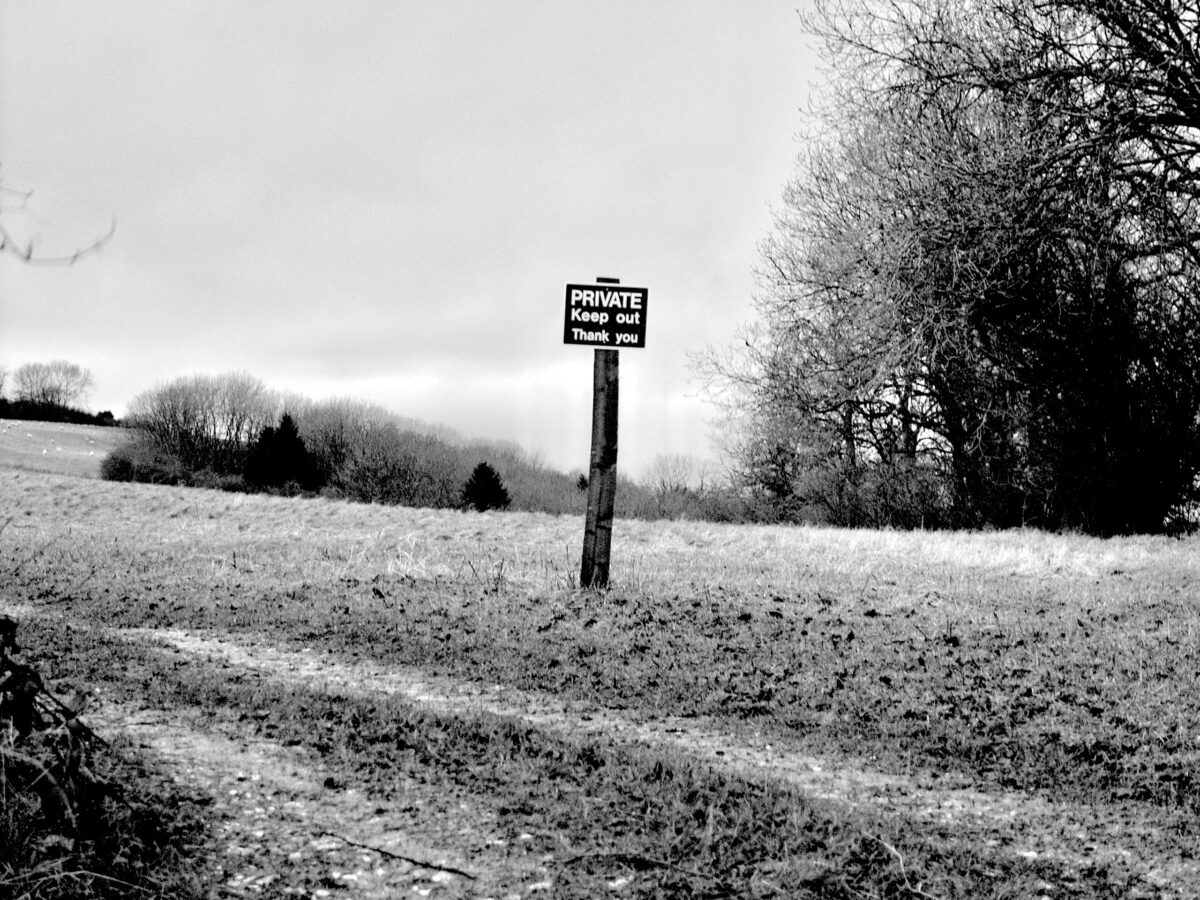Who Goes There? by Vron Ware

The sign is surprisingly polite. “Private Land” (and therefore) “Keep Out” (no “please” though, or “if you don’t mind”) but then, in smaller print, “Thank You” (for what? For your understanding?)
Standing on its own, without a gate or fence, you might wonder what the sign is doing there. Pale dots can be glimpsed in the distance, possibly sheep. But the track leading from the roadside curves invitingly away from the paved road. So how would the owner of the land even know if one was to enter their property unlawfully, especially on foot and with utmost care?
Forgive us our trespasses as we forgive those that trespass against us. We never knew what that meant when we chanted those words in primary school, but at least there was a sense of give and take.
But now it turns out trespassers always were, and still may be, prosecuted, and forgiveness cannot be guaranteed. Turn back now before you cross an invisible boundary.
Two centuries ago, this was common land. I’ve seen the old maps.
“Ye gods above, send down your love.
With swords as sharp as sickles,
To cut the throats of gentlefolks,
Who rob the poor of victuals.”
This is what some of the Swing Rioters sang in 1831 as they fought back against landowners who would replace them with machines, leaving them to starve. By the time the rage had burned itself out, hundreds from across the south of England had been imprisoned or sentenced to transportation and 19 were executed. Their crimes ranged from assemblage, arson and machine-breaking to robbery, writing threatening letters and incitement to destroy. The insurrection became known as the Last Rural War.
Ten years earlier, Constable was gaining recognition for his innovative brushstrokes, attentive to the details of life and work in what we now call “the countryside”. In Syncopated Green we are shown those famous landscape paintings as if in a church: the ornate galleries are deserted, hushed and sacred. The pictures ought to remind us what has been lost, how the land was wrenched from human hands, transformed into wealth, status and power. Instead, over time, those artists lulled us into seeing pastoral England as a pretty, tranquil place, outside of history, all signs of violence removed from the frame.
Why not dance, become entranced, trespass till the cows come home?
How else should we respond to this Malaise? How can we learn to look more carefully, not for postcard-perfect views or the endless green of unpeopled fields, but at the ground beneath our feet? What questions should we ask the tired soil as we make our way across the land, with or without permission?
On public footpaths you’re safe, but avoid the short cuts. Even so, you can be challenged if you don’t look right, if you’re not from round there. Londoners can scare pregnant sheep I was told once, as a friend and I were taking a walk. But I wasn’t from London, and nor was he. We looked at ourselves, asking how we might have been mistaken for Londoners. I was born a mile away, as the crow flies, and had moved to Birmingham. He was born in Cameroon, which is nowhere near London. Even so, he was the Black Stranger who looked as though he might frighten the animals.
Earlier that day we had been in the car and I’d been hoping that he would be impressed by the undulating beauty of the chalk downs. But where I saw a flock of sheep on the far side of the valley, he saw rocky outcrops that filled him with longing for his own homeland. And still, forty years later, whenever I see sheep in the distance I think of Cameroon.
Vron Ware is a writer and photographer, based in London and the South West. Her published work has focused mainly on the politics of gender and race, colonial history, national identity, the cultural heritage of war, and ecological thought. Her most recent book – Return of a Native: Learning from the Land (Repeater Books) – demolishes the fantasy that the English countryside exists as an escape from the mounting crises of modern life.
